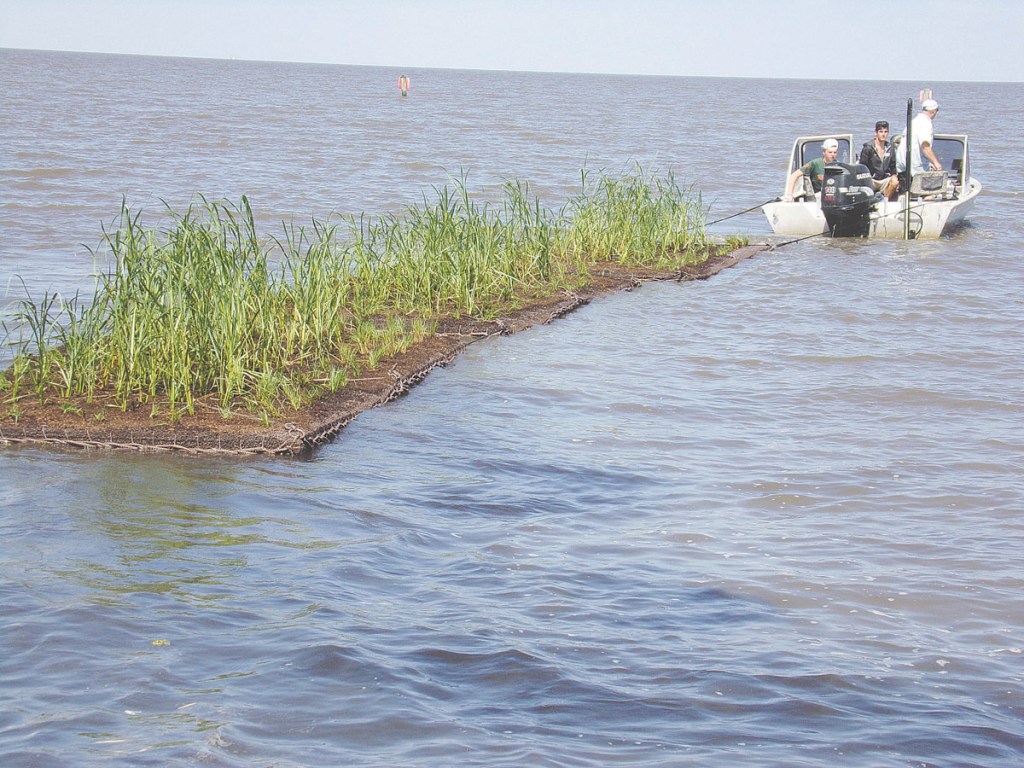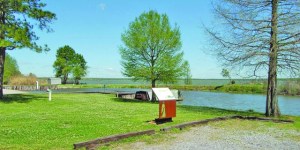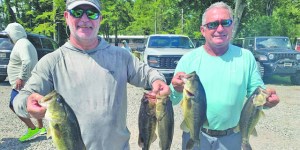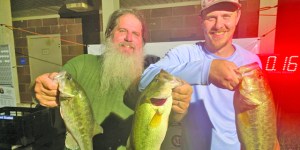Fighting erosion with special mats
Published 12:42 am Sunday, May 20, 2018

- Volunteers manning the three boats had their work cut out for them on a windy day.
CYPREMORT POINT — About this time next year, people will see an expanse of marsh grass in the gaps between and behind the rows of rip-rap along the eastern side of The Cove.
Trending
Hopefully, that is, David Cresson of Baton Rouge, said about midday Friday as he looked at nearly half of the “floating island marsh” mats somewhat in place on the water there in Vermilion Bay. Cresson, executive director of the Coastal Conservation Association of Louisiana, had towed several of the special mats to the anchoring site from Cypremort Point State Park.
Cresson and others were overseeing an approximately $180,000 project to fight coastal erosion with the floating islands, 8 feet x 20 feet mats manufactured by Martin Ecosystems in Baton Rouge. The mats are designed to add marsh grass, in this case 2,000 seashore paspalums and 2,000 cord grasses, that will grow beneath the mat and spread.
The CCA-Louisiana leader said if all goes to plan, the mats won’t be visible at all and all that can be seen will be marsh, even behind the mats, because of the protection they provide from the wind and the waves.
Twenty-four mats were prepared, mostly by 140 fourth- and fifth-grade students from Catholic High School in New Iberia, and hauled by three boats to the site after the project began at 9 a.m. near a large pavilion at the state park.
They were placed end-to-end, roped off and anchored. It was the fourth such project along the coast completed by the Coastal Conservation Association’s National Habitat Program, Building Conservation Trust in a partnership with Entergy, Shell and Martin Ecosystems, which makes the mats at its manufacturing plant in Baton Rouge.
The first project was completed a few years ago in Terrebonne Parish in 2011. In some cases with the first three coastal erosion projects, the “floating island marsh” is outperforming the surrounding natural marsh and nearly 20,000 square feet of new marsh has been created.
Trending
Kirk Sieber, a St. Martinville native who lives on the St. Martin-Iberia line, said, “This is the perfect place to have a function like this. Everything’s here.”
Sieber, a public accountant enjoying his second year as president of CCA-Louisiana, had talked about such a project soon after he was elected president, about identifying a place to implement it — either off Mud Point or just outside Quintana Canal, which borders the state park and empties into The Cove. It came to fruition Friday at the latter.
“We’ve been working on this project for a year,” Sieber said, noting Martin Ecosystems, owned by Ted Martin of Baton Rouge and his family, chose the site based on average salinity, wave action and wind conditions.
In other words, he said at he watched the project unfold on a hot, sunny day, “Where the grass will have the best chance for survival.”
The effort isn’t possible “without all the financial partners who have really stepped up with habitat presentation,” he said.
Sieber was the founder of the Sugar Chapter of CCA-Louisiana, the local chapter. Other Sugar Chapter members on hand to volunteer Friday included local outdoorsmen Kelly Frederick, Chad Courtois, Dusty Hulin and Corry Landry, was was appointed southwest regional director for CCA-Louisiana in January 2017.
The local CCA-Louisiana members set up the tents and hauled the mats, dirt and plants, which were in burlap bags, to the site Thursday.
David Cresson, CCA-Louisiana’s executive director, was on hand, too, and used his Baymaster boat to help tow the mats, which weigh approximately 600 pounds each loaded with dirt and plants, to the eastern side of The Cove. Cresson’s boat was joined by two other boats with volunteer skippers Gunner Waldman of Abbeville and Tom Langston of New Iberia.
The project began shortly after 9 a.m. Cresson, Ed Landgraf, a Shell Oil Pipeline Co. spokesman and project coordinator who is on the CCA-Louisiana board, and Jason Martin, project manager and son of Martin Ecosystems manager Ted Martin, spoke to the students seated under a large pavilion at the state park.
The students, outfitted with blue gloves, then got to work placing plants in the holes of each mat, which were stacked side by side in a row of four under the tents. When the top layer of mats was finished, adults and 10 high school students from AMI near Rayne used polls to carry each one to the water, where Jason Martin and others attached them to the boats for towing.
The first mat was finished and towed at 10:15 a.m.
Nicole Waguespack of Baton Rouge, Martin Ecosystems co-owner and daughter of the company’s founder, was pleased with the progress. And happy to be in Acadiana.
“This is our fourth project. We’re happy to move west. We’ve done three on the east side of the state,” Waguespack said.
Her father got the idea for the “floating island marsh” from a buddy while they were on an elk hunting trip in 2007 in Montana, she said. He started the company in 2008, first inventing the mats to filter storm water and waste water lagoons.
“So dad thought they might have some use in coastal restoration. Today, almost 20 years later, we’ve got two other products we use. But this is the beginning,” she said as she gestured to the piles of mats.
The mats are made entirely of recycled PET plastic. PET is a polyethylene terephthalate, which is used to make food containers.
“That is important because it doesn’t have any chemicals, so it’s non-toxic to the fisheries” and habitat, Waguespack said.
“We inject the mats, or islands, with foam and that enables them to float. Then we drill holes in the top. That’s where the plants go, so the plants grow hydroponically,” she said, native coastal plants seashore paspalum and cord grass came from a nursery in Montegut.
After a year or two, the root system hangs below the island and attaches to the water bottom.
“So, technically, those (islands) are not floating any more,” she said.
The final resting place for the mats preared here Friday was chosen to stop erosion that has been happening behind the rocks. The mats will break the waves and, hopefully, sediment will form behind them.
Waguespack was happy to see the youngsters involved.
“I think for projects like this it’s important for youth to be a part of the project like this so they can have an understanding of what’s happening to our coast, the erosion taking place along the coast, and be a part of the solution,” she said.
by Ted Martin of Baton Rouge and his family, chose the site based on average salinity, wave action and wind conditions.
In other words, he said at he watched the project unfold on a hot, sunny day, “Where the grass will have the best chance for survival.”
The effort isn’t possible “without all the financial partners who have really stepped up with habitat presentation,” he said.
Sieber was the founder of the Sugar Chapter of CCA-Louisiana, the local chapter. Other Sugar Chapter members on hand to volunteer Friday included local outdoorsmen Kelly Frederick, Chad Courtois, Dusty Hulin and Corry Landry, was was appointed southwest regional director for CCA-Louisiana in January 2017.
The local CCA-Louisiana members set up the tents and hauled the mats, dirt and plants, which were in burlap bags, to the site Thursday.
David Cresson, CCA-Louisiana’s executive director, was on hand, too, and used his Baymaster boat to help tow the mats, which weigh approximately 600 pounds each loaded with dirt and plants, to the eastern side of The Cove. Cresson’s boat was joined by two other boats with volunteer skippers Gunner Waldman of Abbeville and Tom Langston of New Iberia.
The project began shortly after 9 a.m. Cresson, Ed Landgraf, a Shell Oil Pipeline Co. spokesman and project coordinator who is on the CCA-Louisiana board, and Jason Martin, project manager and son of Martin Ecosystems manager Ted Martin, spoke to the students seated under a large pavilion at the state park.
The students, outfitted with blue gloves, then got to work placing plants in the holes of each mat, which were stacked side by side in a row of four under the tents. When the top layer of mats was finished, adults and 10 high school students from AMI near Rayne used poles to carry each one to the water, where Jason Martin and others attached them to the boats for towing.
The first mat was finished and towed at 10:15 a.m.
Nicole Waguespack of Baton Rouge, Martin Ecosystems co-owner and daughter of the company’s founder, was pleased with the progress. And happy to be in Acadiana.
“This is our fourth project. We’re happy to move west. We’ve done three on the east side of the state,” Waguespack said.
Her father got the idea for the “floating island marsh” from a buddy while they were on an elk hunting trip in 2007 in Montana, she said. He started the company in 2008, first inventing the mats to filter storm water and waste water lagoons.
“So dad thought they might have some use in coastal restoration. Today, almost 20 years later, we’ve got two other products we use. But this is the beginning,” she said as she gestured to the piles of mats.
The mats are made entirely of recycled PET plastic. PET is a polyethylene terephthalate used to make food containers.
“That is important because it doesn’t have any chemicals, so it’s non-toxic to the fisheries” and habitat, Waguespack said.
“We inject the mats, or islands, with foam and that enables them to float. Then we drill holes in the top. That’s where the plants go, so the plants grow hydroponically,” she said, native coastal plants seashore paspalum and cord grass came from a nursery in Montegut.
After a year or two, the root system hangs below the island and attaches to the water bottom.
“So, technically, those (islands) are not floating any more,” she said.
The final resting place for the mats preared here Friday was chosen to stop erosion that has been happening behind the rocks. The mats will break the waves and, hopefully, sediment will form behind them.
Waguespack was happy to see the youngsters involved.
“I think for projects like this it’s important for youth to be a part of the project like this so they can have an understanding of what’s happening to our coast, the erosion taking place along the coast, and be a part of the solution,” she said.




